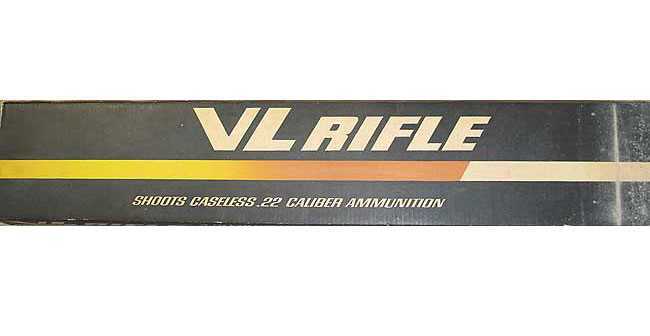
In 1969 the world welcomed the Daisy VL.
This report covers:
- More confusion
- What is the VL?
- The ammo
- Army interest
- Sliding compression chamber
- Only new ones around
- My plan
- Summary
Today BB looks at a firearm that’s actually a spring-piston air rifle — the Daisy VL.
Boy, have I see a lot of misinformation written about this firearm. Yes, the Daisy VL is a .22-caliber firearm and no, it is most definitely NOT the only .22 firearm Daisy ever made. I own a Daisy model 8 that I reported on several years ago and there was another Daisy bolt action called the Legacy that came with both a plastic and wood stock. Actually this VL was also sold with both a plastic stock and a wooden one on what Daisy reverently called a “presentation” model. That one has a brass plate for an inscription on the right side of the butt. It sold for $125 — in 1969, and it came with a fitted presentation case and a thousand rounds of ammunition!
The rifle I’m showing today is the more common VL with the plastic stock. But the price was still $39.95 retail in 1967-’69 when they were made — a time when you could buy a Winchester model 121 bolt action single shot .22 rimfire rifle for $23.95. In 1969, that $16 difference was huge! Daisy was probably trying to recoup the money they paid for the rights to the invention, but it broke the back of the VL rifle. Just 19,000 of the standard ones and 5,000 of the presentation models were made in the years before the ATF shut them down.
But here is the deal. The VL wasn’t just a single shot .22. It was also a spring-piston air rifle. Huh?
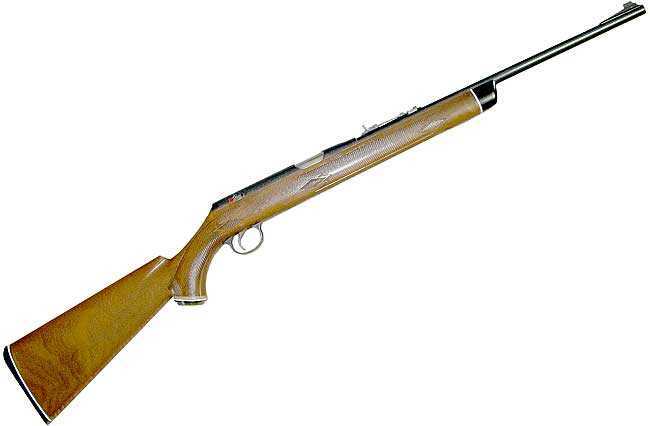
Daisy VL rifle.
The Daisy VL rifle is simply a single-shot spring-piston rifle cocked by an underlever. Load the cartridge in the breech — exactly where a pellet would be loaded.
More confusion
Want more? Well, some folks think the VL isn’t a firearm because it was made by Daisy and doesn’t have a serial number. Wrong! Mine does have a serial number. And the ATF took their sweet time deciding, but a VL is indeed a firearm and not an air rifle. Since they didn’t have a license to manufacture firearms Daisy was advised that it would be better if they didn’t make any more, so the VL, the Legacy and the model 8, which was a Wal-Mart marketing fiasco, all went quietly away. But, just like Wamo, Daisy did make firearms.
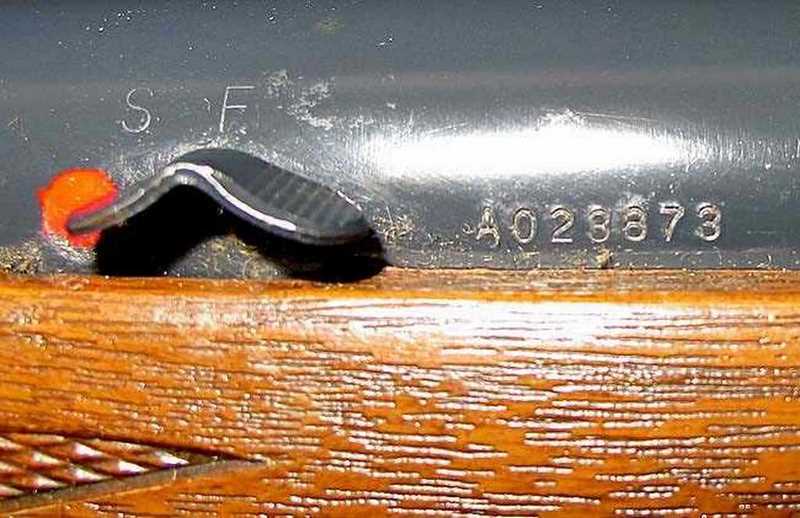
This Daisy VL does have a serial number. And the safety is automatic.
What is the VL?
The VL is a caseless cartridge developed by Belgian chemical engineer Jules Van Langenhoven (VL — get it?). The powder is ignited by high temperature compressed air. We’re talking about the kind of air that’s generated by a spring-piston air rifle. The Daisy VL is a .22-caliber underlever single shot spring-piston air rifle.
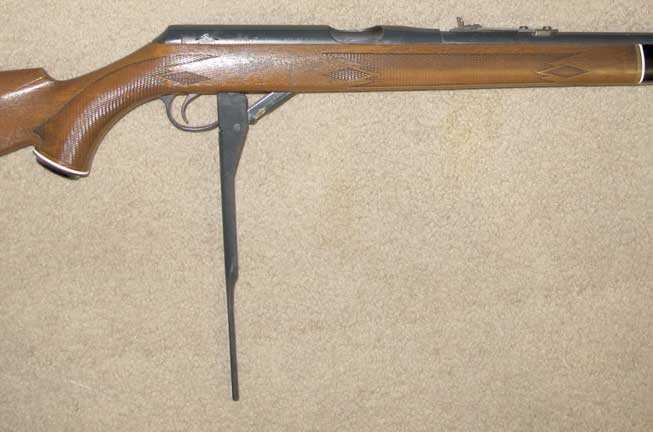
Underlever is down, sliding compression chamber is back and the sear has caught the piston. Load directly into the breech through the open loading port.
The ammo
The ammunition was what made the thing work — the reason Daisy bought Van Langenhoven’s invention. It’s a lead bullet with a small cylinder of white material glued to the base. That material is the gunpowder. It’s half the length of a .22 long rifle yet the 29-grain lead bullet shoots out at 1,150 f.p.s. Daisy said the cartridge had the power of a .22 long rifle cartridge, but in truth it’s more like a high speed .22 short. Twenty-nine grains at 1150 f.p.s. is 85.18 foot-pounds — a trifle over what a high speed short produces and less than a standard speed 40-grain long rifle bullet.
The cartridges come 10 to a tube and 10 tubes to a box of 100. Theoretically it’s safe to carry tubes in your pockets, but I always worried about the powder breaking off. And I think that may have been a major concern about the whole invention — second only to Daisy’s high retail price.
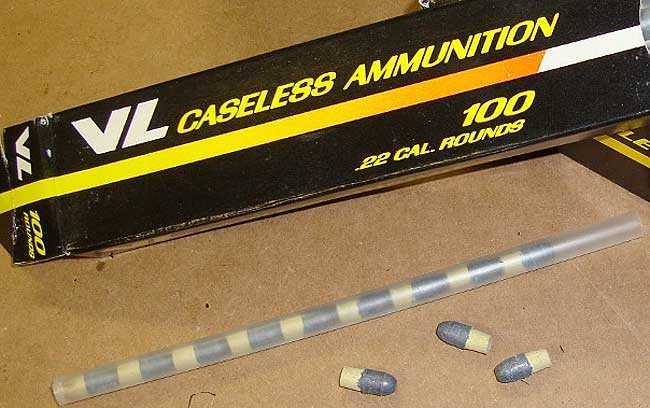
Ten VL rounds to a tube and ten tubes to a box.
It didn’t have to be bonded to the bullet, either. In fact, Van Langenhoven demonstrated his invention at first by pinching off a small bit of his special compound and putting it behind a conventional diabolo pellet in a conventional spring-piston air rifle!
Army interest
The U.S. Army researched the VL concept and made it work technically. It was just as powerful, plus was shorter and lighter than 5.56mm rounds. In that respect it would have been great. Logistically, though, the ammo could not stand up under the rough handling it would get. And believe me — I know! Give a soldier an anvil and rations for a week and put him out in the desert. When you return the rations will be gone and the anvil will be broken.
Sliding compression chamber
Daisy went to great lengths to obfuscate what this rifle really is. Look at their technical illustration.
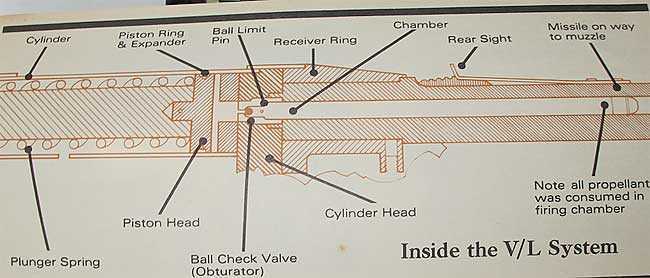
Daisy’s drawing of the VL rifle’s insides.
In fact, Daisy had to stop the expanding gas that was many times hotter and under more pressure than the charge developed by a normal spring-piston airgun. It looks complex in the drawing; in person, not so much. Let’s look at the detailed drawings and read the description of how the breech works and I think you’ll get it pretty quick.
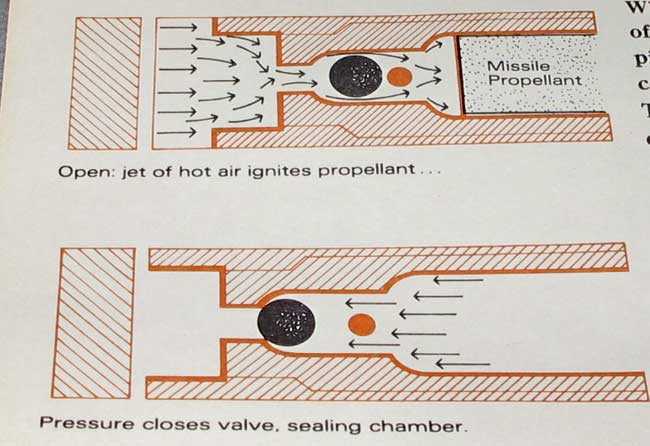
The ball in the breech seals against expanding gasses.
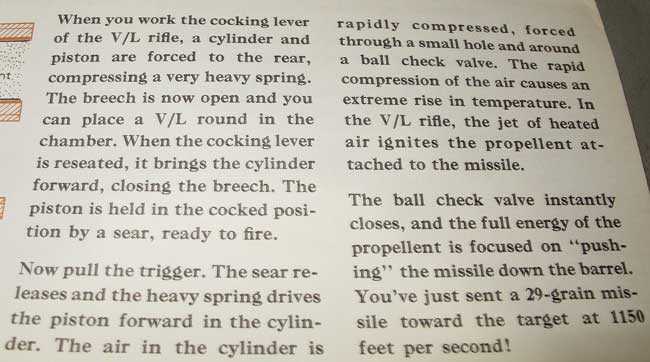
Relate this description to the drawing above to understand how the VL breech retains the pressure of the cartridge.
Pretty neat, yes? But in examining the internal parts I believe it’s safe to say you will; never see a worn out VL rifle. They look like they will be shot out before they wear out. The thin metal parts around the breech will erode from the hot gasses and eventually fail. That’s my assessment, anyhow.
Only new ones around
But here’s the deal. I’ve never seen one that didn’t look new. People bought them but they apparently didn’t shoot them much, if at all. All those I have seen were in nearly perfect shape.
And the ammo was a glut on the airgun market until recently. One-hundred dollars would buy a case of 10,000 rounds at the airgun shows I have been to. Like new in the box standard guns brought $100 if they came with some ammo. I have seen a couple presentation rifles with ammo offered for $500, but there were no takers. The prices are higher today, but they still seem to be without a great following.
My plan
Since I have the gun and a few hundred rounds of ammo, I intend testing it. This will determine several things. First — is the velocity really where they say? And second — how does the passage of time affect the ammo. I know that .22 rimfire can last for a century. How about VL cartridges?
Summary
I have glossed over a lot of data to give you more of the history than facts about the rifle, so Part 2 may have to be a continuation of the description. The length, weight, sights, etc.
I would appreciate hearing from Daisy VL owners in the comments. What have your experiences been? Have you shot your rifle a lot? Is it accurate? Inquiring minds want to know

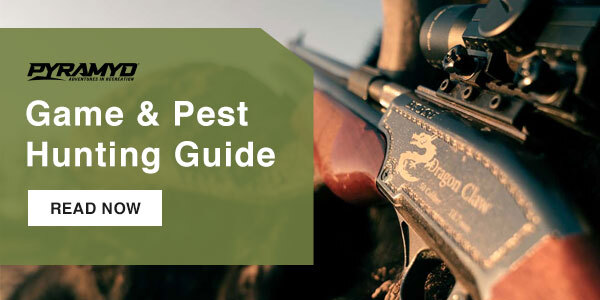
BB,
A report that I have wondered about for some time.
I have noticed that when you talked about the VL in the past, you have pretty much dismissed it as a failure as a firearm, and not very accurate, to boot!
I have been fascinated for years by this platform, thinking that if marketed correctly, it could have ‘caught on’ with the shooting public. I mean, how many people considered a single shot high-power rifle before Bill Ruger made the No. 1? (okay, there was a following, but many more after the No. 1 was released than before)
Not having brass to police up might have been thought to be a positive, (or, maybe, just more ecologically sound?)
Could the accuracy be improved by using the artillery hold? I am thinking that the bullet may spend more time in the barrel, with the springer-type workings dancing around behind it, and that may have an affect on the accuracy.
Definitely something different.
Let the testing commence! (have fun)
Bill
B.B.
Cool stuff! I wonder what the magic chemical propellant is?
How long did the gun’s seals last?
-Y
Yogi,
It really is Missile Propellant ungranulated colloided nitrocellulose:
(Rusty Movie Film) not the modern Safety Base!
https://patents.google.com/patent/US3854400A/en
https://scholar.google.com/scholar?q=Daisy+VL+propellant+composition&hl=en&as_sdt=0&as_vis=1&oi=scholart
You asked…LOL!
shootski
Yogi,
No idea.
BB
B.B.,
Since it fires on compression this works like a Diesel engine or a fire piston although this Daisy VL operates uses a solid propellant unlike the Weihrauch Barakuda EL 54 which uses liquid ether. Why didn’t the ATF classify the Weihrauch as a firearm?
Siraniko
PS: Section More confusion 1st paragraph 6th sentence: “Since they didn’t have a lisence (license) to manufacture firearms Daisy was advised that it would be better if they didn’t make any more, so the VL, the Legacy and the model 8, which was a Wal-Mart marketing fiasco, all went quietly away.”
Maybe the difference is that the EL 54 propelled the pellet by compressed air *and* ether. The Daisy seems to use the compressed air just to ignite the propellant.
Or maybe the Barakuda was so obscure in its day that nobody spent much thought on it…
Anyway, this Daisy gun is weird. It looks like it combines all individual disadvantages of airguns and firearms. I admit I don’t have any firearms experience, but a regular cartridge and firing pin seem like a much more efficient way of doing the job 🙂
CptKlotz,
You are not really missing anything, except maybe the noise.
Yes, a firearm is much simpler than even a “simple” airgun. As you said, this thing appears to have combined all of the disadvantages of each into one. This should be interesting.
P.S. My grandson and I went to the local shooting range to gather a few 9mm casings for mini-sniping targets. There was a gentleman there with an AR15. Though we were wearing top shelf ear muffs, the noise was horrendous. The concussion was incredible. I do not miss shooting firearms.
RidgeRunner,
I hear you on that; the only firearms I have been shooting lately are .22s with the CCI Quiet rounds (which B.B. reviewed for us) or some other subsonic rounds. And I shoot airguns way more, by a factor of 10 or 20 to one, depending on the week. I really appreciate being able to shoot quietly…very relaxing! =>
Take care & happy shooting,
dave
Siraniko,
Got it. Thanks,
BB
BB,
Well,.. that is certainly one of the more interesting guns you have pulled out in awhile. Looking forwards to more reports.
I imagine that people have tried similar concepts by filling the pellet skirt with something. I am not sure what that might be though. Any ideas?
Chris
I saw a video of a guy who filld the base of his pellets with vaseline. I believe it was a Hatsan .30 or .35 ? I was surprised that the vaseline ignited.
-Y
Yogi,
Need to charge that petroleum jelly pellet shooting PCP with Oxygen! Not bam but BOOM!
Wonder the “Lube” it improves precision?
STUPID IS as…!
shootski
Shootski,
Why do you not give it a try and see? It should really make those ASP20s zing. Imagine what you could do with a Quakenbush.
RidgeRunner,
LOL! Maybe because I wasn’t born yesterday is why I must RESPECTFULLY decline your suggestions
shootski
Yogi,
That is almost as stupid as the moron who went to the local National Forest shooting range and was shooting tracers. One ricocheted into the woods and set the mountain on fire.
I am not surprised the vaseline ignited. High pressure air and petroleum do not mix well. That is how a diesel engine works. One day I was shooting my Gamo CFX that PA had just put a gas sproing into. Apparently one of the seals gave out and allowed some grease into the compression chamber. It sounded like a .22LR going off with a considerable cloud of smoke, not only coming from the muzzle, but from around the loading port as well. It blew out every seal in that air rifle.
PA was nice enough to reinstall my sproing, rebuild my rifle and refund my money. That is customer service that brings customers back.
Chris,
Yes they certainly have tried, but I don’t know with what – this is taken from Lesley Wesley’s ‘Air-Guns and Air-Pistols’ – it’s not clear when this would have been written as I’ve got the last printing (1978) of the last edition (1971) of his book that first appeared in the 1950s.
Iain
Actually, reading a bit more he does describe the V/L system in the final chapter entitled ‘Later Developments’.
It’s not clear whether this means he actually saw one in the flesh (he did work in the gun trade, so it’s possible) or he’s just taking the description from Daisy marketing material.
Iain
Lain,
Thank you very much for providing additional information/research. Very interesting. One thing for sure,… it would seem that the check valve (ball) is key to operation,… which is what a conventional springer would be lacking.
Thank you again,….. Chris
Chris,
Using his doctored pellets he does mention the flash and kick, so you do wonder what that did to the mainspring and piston seal.
iain
In 2019 I did some research and experiments involving compression ignition. Having had an interest in diesel engines I was familiar with the subject. I discovered the Daisy VL by accident but immediately knew I wanted to try to replicate the design. Being a hobby machinist it didn’t look too difficult. I ordered a cheap Chinese underlever B1-3. After completing the valve I set out on testing various combustible powders and liquids. Ether, WD40, match heads, finally smokeless gunpowder. I lost interest in the project after buying my first PCP rifle.
Bug-a-salt: Co2 powered and revolver. Just passing it on after seeing it linked on AGN.
https://www.bugasalt.com/
Chris
Chris USA,
Do you think it will take out Cycads?
Maybe needs a POWER MOD kit!
shootski
Chris,
That looks sweet! A bit more expensive to shoot with the ammo costing $12 for 120 rounds, plus C02. Wonder what the velocity is. Pattern? B.B. reviewed the Bug O Salt gun before, maybe someday he will do this one. Thanks for sharing
Doc
This appears to be based on the same platform as the Crosman Vigilante and Triple Threat. The SHRED-ER is out of stock, but I’ve ordered some cartridges to see if they work in my Vigilante. They should be here in 7-12 business days, I’ll let you know what results I get.
That was my first thought also Crosman Vigilante. should be able to refill the salt in the cartridges with a little tinkering.
Don
Don,
I do hope so. If so, it could be loaded with sea salt or some other larger grained salt. Buckshot.
AG,
Please do! I may buy a CO2 gun yet.
Chris,
Though the ammo seems a little pricey, I think it is still cheaper than for the Gamo Viper. I wish that air rifle was not so expensive. It is probably the easiest and cheapest to make of all of the Gamo line.
This thing would probably work great against the carpenter bees around my place!
I load my Beeman break barrel with tissue paper wadding and about 3/8 inch of table salt. Can kill spiders and flies from a good distance. If you are too close there will be nothing left.
BB,
This is going to be pretty cool to “hear” about. I am curious though as to how well it will work as an air rifle. I do hope you test that also.
In the sixties the Air Force experimented with “caseless” ammunition for the weapons on their jet fighters. At their flying speeds you do not want to eject brass cases out as they would very likely damage the skin, so they have a compartment to catch the empties and belt links. Their findings were the same as the Army’s, too fragile.
BB,
Dont forget the Gyro Jet! It looks like a cross between a BSA 55, AA TX, but it did come with sights.
I like the ergo’s of the cocking arm, but I wonder if folks complained about the new wonder material called plastic. I think we are over the ‘newness’ of plastic now. Plus what about hang fires? I think caseless ammo is a step in the direction away from being able to roll ‘yer own in general, but that is how its been with rimfire ammo for a while now, anyway. I think in an M1 Abrahms, the case is consumed, and a tank has that problem of hang fires as well. Dont want to open the breech while something is smoldering in there.
Rob
Rob,
We’re a step away from reloading unless someone sells the material and we use it with pellets.
BB
B.B.
I’ve always wanted a VL. Only think that stopped me was worrying the ammo would dry up some day. Neat gun.
Doc
Doc,
Well, we will find out if now is “some day”. 😉
BB
Folks, I really need to thank RobertA for inspiring me to actually put my low pressure airgun valve into a gun (loose definition of gun here). I decided to just start putting it together on a piece of lumber. I think that was a good start as I was not trying to come up with something that looked good, just something that worked. All the parts except for the 7/16 shaft sleeves with set screws were from my junk bins.
I described the valve earlier around the end of November 2020 in the blog. My objective was to come up with a pellet gun that can run off of a typical home/shop air compressor. The valve has the valve stem under constant pressure where it leaves the back end of the valve. It does tend to leak a little through the packing on the old gate valve bonnet I used for the seal. Normally a leak in a pellet gun is very bad, this one though uses air from an air compressor that really does make a difference. If there is a small leak the compressor might only kick on once every 50 shots even with the leak in the valve and the leaks in the hose connectors.
The trigger is a bit gangsta style coming off the gun horizontal on the right side. It is very rough although it is getting better with use and some polishing. Part of the problem is the leverage arm from the pivot to the sear is longer than the pivot to the trigger. So it takes more force on to pull the trigger than it would to just pull on the sear. It does have an adjustable trigger stop but no adjustment for sear engagement at this time.
I first tested the gun with just a laser sight on the end of the barrel at 16 yards, I figured the laser sight mounted on the end of the barrel would ignore all the sloppiness in the rest of the gun. I used 16 yards because that was in the shade. I got a 10 shot group of 0.57 inches. That was better than I had hoped for. I had a problem seeing the laser dot on the target so I mounted my binoculars behind the gun figuring that would make a difference (See Picture below). It did my 10 shot group opened up to 1.70 inches with 8 shots in 0.90 inches, what the heck I could see the laser very well. I figured the binoculars must be messing with the guns harmonics. So I used my spotting scope on a tripod and tried again. This time 10 shots were in 1.07 inches, still worse than with my normal poor vision.
After I completed the first 10 shot group with out the binoculars or spotting scope my 1/8 inch tether air line made from some medical oxygen hose blew up so I hooked my compressor hose directly to the valve. I now think that was what messed with the guns balance and harmonics when I used the binoculars or spotting scope.
For all these tests my gun was hooked directly to my air compressors tank not through the regulator. The pressure was kicking on at about 100 psi and kicking off at about 125 psi. I have only shot .22 caliber Air Arms Falcon 13.43 gr pellets in this gun so far. From my earlier velocity measurements this should give velocities from 450 to near 500 fps. Note that for each 10 shot group the pressure variation would have been minimal so thus the velocity variation should also not be an issue. I will need to do a new set of velocity tests now that the valve is actually in a gun, well kind of a gun anyway.
At this point in the testing I decided that the gun deserved a scope for better testing and to see how will it could do. I made the scope base so it could be rotated and tilted to zero the scope. I reset the scope I selected so the turrets were in the middle of there adjustments and then adjusted the scope mounts until the crosshairs were on the laser dot at 20 yards. Having the laser probably saved me many hours getting the scope set up. I sighted in the scope and then proceeded to shoot some 10 shot groups. The first 10 shot group was 0.80 inches, the second group was .87 inches and the third group was .76 inches. After those 20 yard groups I moved the target back to 25 yards and the group opened up, the 10 shot group was 1.57 inches.
I think in summary that the trigger is the next thing to work on to get the best from this gun. A sear engagement adjustment would probably help. I expected poor accuracy with all the parts mounted on a 2×4 but it seems to be doing ok. The barrel is held against the probe with a spring but I think most of the harmonics are in line with the barrel. I was able to micro-adjust the barrel and valve alignment by smacking the pipe clamps with a ballpeen hammer.
Don
Don,
Awesome dude! 🙂 You have a working model. Very much looking forward to further updates. In concept, that is a pretty good leap forwards in the air gun world.
Chris
Chris thanks, I am not getting notices of responses on my email. I will check back when I can.
I really think with some optimization 500 fps with 100 psi is easily attainable. If you are shooting from a fixed position; using a 1/8 inch tether to an air compressor with 100 psi the tether is not even noticeable. Shooting my LPPG (low pressure pellet gun) is very enjoyable. After loading the pellet and cooking the hammer I still feel like there should be another step before shooting. Even a cheap 12 volt compressor will power the gun. I should try mine.
There is a whole array of tests I can do. So far I have only used one pellet and one power source. Right now the trigger is about as bad as my worst out of the box airgun trigger so that can easily be improved.
Don
Don,
Excellent frankengun, reference here for the valve build /blog/2020/11/oil-talk-and-no-action/#comment-466491
Love the scope mount, well done.
Mike
Mike,
Thanks, I knew the date within a day or two but could not find my way to it.
Don,
This is a superb proof of concept. Perhaps you should contact Lloyd Sikes as he has experience in turning a proof of concept into reality in the airgun world. BB has a little experience there also. 😉
I have always been intrigued by the use of “low” air pressure in PCPs. This is why I picked up a Maximus recently. The real old PCPs used 600-800 PSI. Why not 100 PSI? Yes, it will likely require a longer barrel than many of today’s air rifles. It may also require some valve “work”, but I do believe it is possible. Maybe it is just wishful thinking on my part, but I think it would be a fascinating air rifle to own.
Perhaps the most difficult hurdle to overcome will be the volume of air needed to achieve “usable” velocities with various calibers. Carrying an air rifle with a very long barrel and a huge air reservoir will definitely be a major limiting factor.
Having said that, why not something around 1000 PSI? We have now entered the realm of sproingers and CO2. Many of the new airguns are regulated to lower air pressures and reservoirs are filled to incredible pressures to give incredible shot counts.
I know this is a limited market composed almost solely of collectors and shooters who have learned they do not need over 2000 shots per fill. The old PCPs would give quite a few good large caliber shots per fill. It can be done.
I do like the way you utilized the AirForce barrel.
RR,
I have no desire to make this concept into a commercial enterprise. If anyone wants to take it in that direction I am fine with that.
Following RobertA on his journey with his gun made me realize that this gun can be the ultimate tinkering project. It works now and is fun to shoot. I will not be carrying it around. Just sitting on the back porch and plinking.
My next effort will be improving the trigger. This is fun for me.
The barrel is a Maximus barrel, with the Crosman target barrel weight and dove tail grooves for the laser.
Don
Don,
I saw those bushings on the barrel and thought they were the AirForce barrel bushings. Unless I am mistaken, you pull the barrel forward to reload in the breech and the spring tension holds the breech in the transfer port?
Yep you got it!
Brilliant! More! Robert.
Here is the gun with the scope.
A closeup of the trigger cocked.
Benji-don,
Wow. Learn by doing. I would recommend seriously experimenting with your trigger. Make as many different ones as you can and try them out. Avoid cannibalizing parts off new triggers (
yes this is more work ) but you can then have a nice display of trigger development. Move your pivot around, try different lever lentgths etc. There are quite a few rifles that have one lever( trigger is that lever ) so you can look at how they are designed. I think BSA do a single lever design etc. It will be backwards to yours BUT the idea is get a good trigger that works then change it to your requirements. If you add a block of wood that is level with the trigger lever you can drill pivot holes all over and use different levers until you get a good one. THEN you can finish it. :- ) I will draw a diagram for you. : – ) Robert. ( Wow it’s raining like mad here )
Benji-Don,
You need to moly the heck out of tht Trigger, LOL!
I love your refined Windage adjustment method too!
Looks great and it sure seems you are having a GRAND time shooting
Ma Air Board ;^)
shootski
Shootski,
I gave the trigger and hammer plenty of moly. Did not help much. Just got moly all over my fingers cocking the hammer. Then put the hammer in my drill press and hit with 100 grit then 240 grit. That made the trigger twice as good. Next will be polish for both the hammer edge and sear. It still needs a sear engagement screw to reduce the creep. Nothing worse than a long rough creep.
It is a very fun gun to shoot.
Don
Don
I remember back when you were talking about doing it. Glad you finally did.
I always thought that low pressure air could work for a air gun.
Cool stuff.
GF1,
It is easy to find a 200 psi compressor, the presser vs velocity curve was still pointing up when I reached 110 psi so I believe higher velocities are achievable. My earlier testing was done with the gauge on my compressor tank. It was reading high. I will find the chart I did with my regulator gauge and post it.
Don
Don
I remember you posting charts in the past. And it sure looks like the velocity is increasing with higher pressure.
As I have said before I just hope you take it somewhere. I sure would love to own one and be able to buy from a store one day.
Here is the chart
Off Topic,
But amazingly cool, cat makes a life saving leap from a burning building.
https://www.bbc.com/news/av/world-us-canada-57124736
Nice landing.
Mike
BB,
I’m more excited about this gun than most of the ones that appear here as historical pieces. I remember reading a long time ago about the US and NATO trying to develop a battle rifle that used a caseless ammunition to reduce weight. I think maybe H&K made one ( the airgun company RWS was somehow involved with that one as well). I don’t recall ever hearing about this gun. This is Buck Rogers stuff and I look forward to the next episode.
Is anyone else finding that they are having to re-log in much more frequently than was required before the site was “improved”?
Half
halfstep,
I have to log in everyday if I want to reply to somebody. It used to be I would have to do every so often in a week. The Heckler & Koch G11 was the last rifle created using caseless ammunition. I recall S&W modifying an M76 using caseless electrically ignited ammunition in the late 1960s for experimental purposes.
Siraniko
Half,
Years ago I met a gentleman at a rifle match, that said he had the opportunity to examine one of the H&K prototype rifles (not sure how he did that one). His comment was that a battle rifle is supposed to be as simple and solid as can be, since battles tend to mess with complications. After examining it, he said that he was impressed with the precision of the internal mechanisms (to include at least one bell-crank) and the ability of the German engineers to make it work, but really has his doubts about it “ever becoming a primary battle rifle.” Maybe luckily for the Bundestag, “the wall” fell, and Germany was awash in small arms.
Who knows what might have been?
Cheers.
Bill
billj,
It has been my experience that Germans tend to take the engineering too far. they tend to take a basic concept and engineer it to perfection. A prime example is the Tiger tank of WW2. When it worked, it was awesome. The Germans lost more Tiger tanks to breakdowns than battle.
One of the best tanks of WW2 was the Russian T34. It had a drive/wheel/track system that the US Army had rejected years earlier. It had sloped armor, was simple enough for an uneducated peasant to learn to keep running and had a gun that could penetrate even the frontal armor of the Tiger.
Benji-Don,
Since you are having fun shooting your LOW pressure airgun I suspect we will be seeing more improvements and modifications. Getting it done with 100 or so PSI is probably going to get others thinking about the low pressure possibilities; can’t hurt!
If you take on a major mod to that trigger think about using a geometry to just pull the sear to the side at right angle instead of what looks like a push toward the valve spring pressure. That is a pretty big trigger Mass so you may want to think about putting it on a hole diet. Every little bit helps.
Best,
shootski
Shootski
We have talked back and forth about low pressure air guns on the blog for years.
But Don finally started messing with it. I think it’s a great idea and glad he gave it the go.
Hey Gunfun1,
I think we would all be benefited by the efficiency it takes to get performance through the FLOW that Don is working to achieve!
I agree
Absolutely!
shootski
Shootski
Yep 100%.
Shootski,
That was a trigger I found in one of my parts boxes, I think i have a few more just like it. No idea what it came off of, it was either in my Benjamin or Crosman bin. I chose it because it was set up to release the hammer moving toward the shooter. That reminds me I should put a shield behind the hammer. If the nut comes off the valve stem the nut behind the trigger could easily loose a tooth.
First I am going to try to tune the existing trigger configuration. I have been thinking of using a solenoid trigger then I can put the button where I want it.
I bet the 2×4 is going to drive Hank crazy.
I still have only tested one pellet in the gun so there is a long way to go.
Don
Benji-Don,
“I bet the 2×4 is going to drive Hank crazy.” Don’t let it bother you! When you get closer to a satisfactory development design if he is really upset with the 2×4 he could offer to craft a stock for it, LOL!
Keep trucking… BIB Thumbs Up!
Don’t forget to shoot it often,
shootski
Trigger warning.
So I am fiddling away with my trigger idea and it’s actually coming on quite well. I reduced the spring pressure and shaped the hammer a bit. So the lump on the right hand top side of the hammer is the hammer face. It is pulled back by the trigger and then released when the trigger runs off the edge of the ledge on the hammer. The idea is that it has long travel, is light and breaks clean, and yes it actually does.
The recatching the hammer is done in a double action revolver with a “fly catch” or what ever people call them. A small lever or peg would do to recatch the hammer. Even as a model the trigger feel 900% better than the Gamo trigger I have. It’s one stage all the way and breaks at the same place everytime. Whats more it could actually have a “set trigger” the brings the trigger group into a much shorter travel. So you can pull it full travel OR set the set trigger and pull it through a short travel. The trigger pull weight is the same for both, you are only changing the travel. I think I can actually retro fit this non destructively into my actual Gamo trigger group. Another thing I was considering is having a trigger travel indicator. When you get to say the last 1/4 of the travel a light turns on in your scope FOV. This tell you you are at the “Click Bang” stage. Feather light and super short travel triggers are not my style. Possibly action shooters might understand: you are totally in charge of the trigger. You are not waiting to settle down and you want a hard defined line which is not easy to cross but you can do it purposefully and repeatably. There will be a point where struggling with the trigger is counter productive ( and probably quite safe ) but I am miles away from that . In this latest pic you can see the three steps in the action. The “recatching” the hammer is fully manual so far. : – ) Robert.
RobertA,
Progress! So you will end up with a double trigger set up. One to recatch the hammer and the other as the actual trigger. You may need to make a new trigger housing too.
Siraniko
Siraniko,
Well maybe. A new trigger housing is a lot of work! Could be done. I would need a lathe to turn up the tube end, drill the end pin hole, weld a plate on, work out how to get the pivots to stay in. If I undersized the hole then ream then press in. That’s the hard part done! Sure. I think I will investigate triggers and hammers and make some models. Find the best on before I go off half cocked! I will mount my first trigger in a frame and hang it on the wall. Fun! : – ) Robert.
RobertA,
Interesting proof of concept.
RR,
Thank you. It’s no more than a transplanted double action trigger group. It just looks a bit weird. The whole trigger sear hammer system is very engaging…. Robert.
RobertA,
Glad you are working on triggers, that is what I will be trying to improve next on my low pressure airgun I showed in the above comments. I don’t think I would have made it into a working model without your inspiration. Your enthusiasm on your projects got me started.
I am planning on using a crossbow trigger group but it will have to rotate in the opposite direction because my hammer pulls the valve open. Here is a link to the crossbow trigger..
/blog/2015/09/a-special-trigger-from-the-past/?swcfpc=1
Don
Don,
Since you now have the low pressure air platform,…. a full auto bb shooter would be cool to have a go at. No valve or trigger or timing anything,…… just turn on the air and have the bb’s feed in. Gravity fed? Air pushed/fed through a hose/tube?
Just an idea,……… Chris 😉
ChrisU,
I have seen some bb guns on YouTube just like that. I think you should give it a go. I am not into full auto.
How are your peppers doing?
Don
Don,
Well, it looks like your 99% of the way there. Just an idea.
Peppers? I think I will skip them this year. I had more than enough Cayenne and Ghost last year and made hot sauce (2 types) to last me all this year. About 8 drops of the Ghost in any dish is all you want. The only thing I have going this year is some rainbow Swiss chard,.. from seed. In 2 days now.
I do not have a garden per se. More like a 12′ strip in front of the front deck,… and pots if I wish.
Chris
Banji-Don,
WOW. Cool!!!! I missed a lot of the action being in the garage furiously filing… Do you have diagrams? they are the best. Schematics etc. I use pencil and paper or MS paint. I found that CAD programs were too slow for rapid sketching.
Will have a good look at your project! Robert. : – )
RobertA,
Here is what Mike in Atl recalled
Excellent frankengun, reference here for the valve build /blog/2020/11/oil-talk-and-no-action/#comment-466491
Siraniko
Off topic, but an interesting point I’ve just come across.
There’s a fairly new budget break-barrel springer, which Diana have got in their line as the P-Five (Model 5 is a very iconic name for them)
https://www.diana-airguns.de/en/products/break-barrel/detail/diana-p-five
although it is Chinese-made, by Snow Peak/Artemis, and that’s the name it’s being distributed under here in the UK. Now as soon as I saw this review and the action out of the grip, that looked very familiar.
https://www.airgunforum.co.uk/community/index.php?threads/new-pistol-day-its-a-springer.343562/
That looks very much like it’s based on this Turkish semi-recoilless break-barrel
http://www.muzzle.de/N7/Druckluft/Voltran_BLOW_H01/voltran_blow_h01.html
Whereas a conventional break-barrel would have the grip/frame attached by having screws go into the trigger housing, that Voltran design has two small cradles that fit around the housing first – you can still see in the Snow Peak the two short sets of rails they would fit on – and the grip attaches to those. The gun remains quite small and compact though, compared to some break-barrels. The large bulbous end cap houses the recoil-absorbing spring; this has gone on the Snow Peak, and it looks to have screw holes in the housing so the grip attaches directly to it.
Whether this means we might one day see a P-Six or a P-Ten in the Diana range, I doubt.
iain
An update on my low pressure airgun above. I tested my trigger with my fish weight scale. The retun spring pressure is 1.5 ounces and very smooth. The single stage trigger broke at 1 pound 8 ounces and had quite a bit of creep. I polished the trigger and hammer contact points. It now brakes at 1 pound 4 ounces with no creep. The break is fairly crisp. This made the trigger very usable so more testing will be in order.
There is a problem with my hammer though it is made from a low carbon steel or cast iron. The sear is leaving scratches on the hammer with every shot. Eventually it will get rough again. Maybe I can try some heat treating or tempering of the hammer. Or make a new hammer out of a better steel.
Don
I just finished testing the velocity vs air pressure with the gun. My original test was with the barrel in a vice and just holding the valve probe in the barrel by hand.
The velocity followed the same basic curve as the first test but with lower velocities when the valve is in the gun. I think it is because by hand I was pushing the hammer until the spring was completely compressed. In the gun there is still some compression distance left in the spring when cocked.
I think this tells me the valve is not staying open until after the pellet leaves the barrel as I had designed for. That means the gun is tunable by changing the hammer spring, hammer weight, or the amount of spring compression. I think my next effort will be to try a stronger compression spring.
As it is now the velocity spread is very low at any given pressure. I shot two shot groups at each of the pressures all of the two shot spreads were none to two fps.
As it is now the valve is opening 0.34 inches.
Don
BD,
Highspeed camera and microphones. If you use two mic’s ( left and right ) you can close mic the muzzle with one channel and then close mic the trigger with the other channel, then video the trigger operating. you then have the sound track of the action and video. If you use a sound engineering program you can see the sound waveform. It’s super cool for capturing events. Just an idea! Robert.
Robert,
I don’t have a high-speed camera, but my son has a recording studio. With at least three microphones it may be possible. Hearing the valve close may be tricky though.
BD,
Add on webcams can be quite fast. You may have a good one that you are not aware is good! With some web cam capture software, a laptop, USB audio input device and some mics you can really start logging action.
Your valve stem is that long rod, right, so it stick out. If you mark it with HiViz marker you should see it open and close. I have a sony Play station cam that does 120 FPS. It’s low rez but that still might be enough. 400×300. Depends on how close you are. Should actually try it out myself. Once you get a system running you can have endless fun doing diagnostic telemetry logging !!!! more fun! : – ) Robert.
Random DIY stuff:
Car gets me to the range with my gear. So fixing the car is part of the “going to the range” process. Ergo it’s part of the overarching story. I present: my bench top valve compressor! Super cheap and way way better than those expensive modified G clamp things. Screw the thing to the bench and lean on it. Too easy. I stuff a rag under the valves. Next up I have to wire brush 16 valves then lap them… FUN !!!! Robert.
Hi BB, this article is very interesting. Is this similar to dieseling some folks use to increase the power of their pellets?
Regards,
Peter
Peter,
That isn’t dieseling, despite what the You Tube videos say. It’s detonation — an explosion cased by heat and combustable material.
Is it the same as the VL? Not exactly, but it sure is similar.
BB
Hi B.B.
My Dad gave me a brand new VL when I was a kid. I tried to shoot it recently, but gave up after three or four failed attempts. I assumed the powder charge had gone bad over the years, but now I’m wondering if a seal has gone bad. Perhaps you could address this in Part 2? How do you determine a bad seal, where can replacement seals be obtained, and how difficult is it to replace?
Regards,
Kennon
Kennon,
Put a .22-caliber lead pellet in the barrel. Don’t be afraid because the VL was an air rifle made by BSA.
If the pellet won’t shoot out, the seals are bad. If t6he pellet shoots out hard enough to dent a steel can the seals are fine.
BB
BB,
So your assertion is that the compressed air charge should blow the bullet down the barrel even without the boost from the powder charge?
Since the VL ammo is .22 caliber, shouldn’t it work the same as a regular .22 pellet? Or is the VL bullet slightly larger?
(This seems to contradict something that happened to my VL. My memory is fading, but I think I recall an incident in which a round became stuck somewhere down the barrel and my sister continued to fire it until several rounds had clogged the barrel. My Dad tried several different methods to unclog it, but finally gave up and ordered a new barrel.)
In my recent attempt to fire it the rounds did not move down the barrel. So if your assertion is correct, it has a bad seal. Where can I find a new one?
Sincerely,
-Kennon
Kennon,
The VL rifle is an underlever pellet rifle that shoots VL cartridges. The heat of the compressed air ignites the power on the cartridge.
Twenty-two caliber pellet rifles do not have .22 caliber barrels. They range in size from 0.2165 to 0.218-inches in diameter. A .22 rimfire bore is 0.223 to 0.2235-inches. The VL: barrel is sized for the larger projectile.
For a new seal you will have to search or perhaps make one yourself. BSA is no longer in business. Gamo bought them out years ago and no repair parts are available.
BB